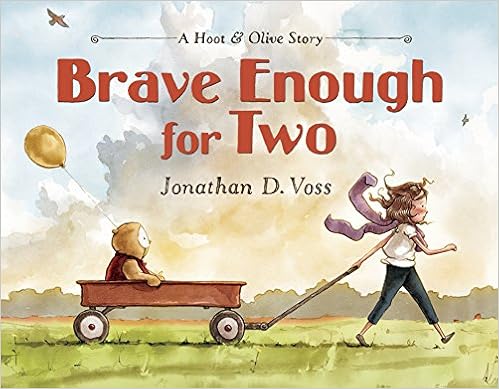Some days we are our own worst enemies. The messages we tell ourselves can be the very thing that holds us back. Some days the most important thing we can do is show up. How do we push ourselves through these hard days? How do we stand up and step forward?
In our classrooms, we work to help our learners be fearless. There's power in taking risks and pushing through the hard parts of our day. These three titles will help students to find ways to be brave.
Brave Molly by Brooke Boynton-Hughes
If you love wordless picture books, you'll love Brave Molly. The story begins as Molly is working to draw a picture of a shadowy figure. Molly sees some kids outside and decides to go out to where they are. The shadowy figure seems to follow her. As she gets closer to the kids, they walk away. The boy leaves a book behind. Molly heads through the woods with the book in her backpack and the shadowy figure close behind. Molly decides to be brave and push on. Will she ever get rid of the shadow that follows her?
The Way You Might Use It:
Community Conversations: Being brave, doing the right thing, taking care of one another and the power of friendship are all certainly topics of conversation this book might inspire.
Anchor Text: We learn a lot about this character across the story. Even though there are no words, there is plenty of room to talk about what this is like. The book also provides some great opportunities to wonder together about what the shadow represents (or even if it is real), her motivation in getting the book to the boy, and how the author wanted us to feel (and the decisions made to accomplish that).
Mentor Text: The author/illustrator moved between panels, single page illustrations, and double page spreads. The panels are used to move us through time quickly. The author/illustrated used changes in color to help create mood and portray the way the character might be feeling. Young writers might find ways to try these craft moves in their own writing.
Brave Enough for Two by Jonathon Voss
Sometimes the best way to get through hard times is to have a friend by your side. Olive likes the adventures in stories, but she doesn't feel brave enough to tackle these adventures in real life. However, with Hoot by her side, Olive finds the strength to try things she finds a bit scary. This story illustrates the way hard things can be easier with a friend by your side.
The Way You Might Use It
Community Conversations: This book could help communities talk about the things that are hard for us to do or times we've been trying something a bit scary. Kids have many experiences that require them to be brave such as learning to ride a bike, playing a new sport, or going into the basement to get something for their mom. There is also some space to talk about how we can take care of each other and help our friends through the hard parts of our day from working on a hard math problem, digging into a science inquiry, or crossing the monkey bars for the first time.
Anchor Text: This book would support conversations about how characters change across time. It also demonstrates the way we can make inferences about characters based upon dialogue.
Mentor Text: This cumulative text gives young authors ways to think about adding multiple events to a story to help illustrate a point and clarify the message. The use of dialogue might also help young writers think through the ways the authors carefully select conversations that help us to learn more about the character.
When You Are Brave by Pat Zielow Miller and illustrated by Eliza Wheeler
Certainly kids today have many reasons they have to be brave. In this story, the character's family is moving to a new place that seems far from where they had been. The character is uneasy and feels very alone as she works to take a strong step forward. In this book, the author shares some ways we can find our courage in the hardest of times. While there is much to love about the story, the illustrations really call readers back again and again.
Community Conversations: Students will be able to identify the times the author shares that we have to be brave. Communities can begin a conversation about the way they work through hard times and find their courage.
Anchor Text: You really can't have a book about being brave without having ways to talk about the character. How do we know how the character feels? What clues did the author and illustrator give us?
Mentor Text: Young writers can have much conversation about the lead in this book. The author uses repetitive stems to strengthen the message. The author begins, "Some days when everything around you seems scary...you have to be brave. Brave as....". The author does this in other places in the book as well as uses changes in sentence length to change the pace of the reading. How does this impact the message? This book might inspire some brave writing.




Do you have copies of these books in the library.? I can see the potential for a lot of writing activities with these books.
ReplyDelete